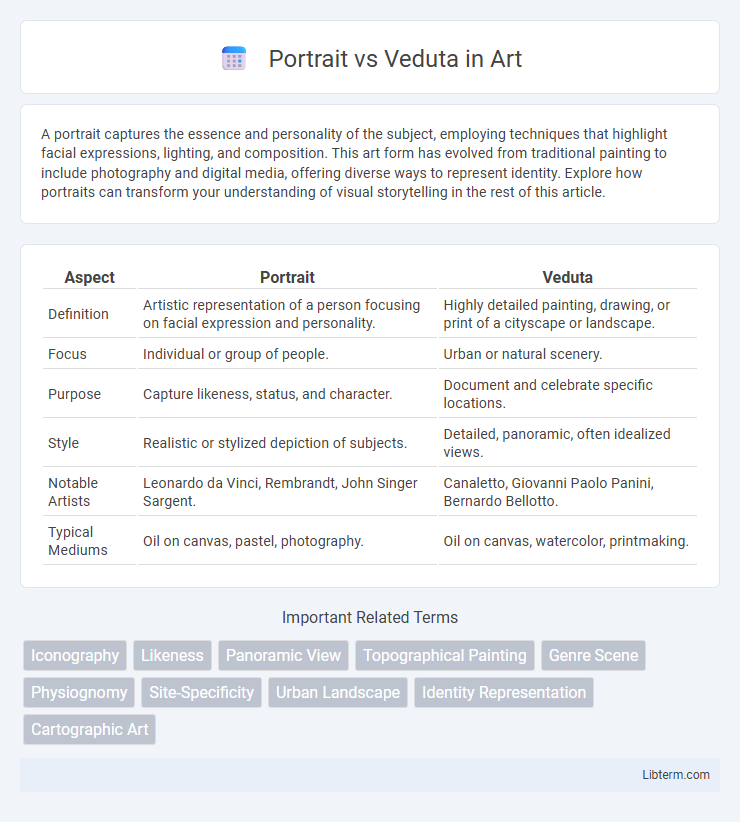A portrait captures the essence and personality of the subject, employing techniques that highlight facial expressions, lighting, and composition. This art form has evolved from traditional painting to include photography and digital media, offering diverse ways to represent identity. Explore how portraits can transform your understanding of visual storytelling in the rest of this article.
Table of Comparison
| Aspect | Portrait | Veduta |
|---|---|---|
| Definition | Artistic representation of a person focusing on facial expression and personality. | Highly detailed painting, drawing, or print of a cityscape or landscape. |
| Focus | Individual or group of people. | Urban or natural scenery. |
| Purpose | Capture likeness, status, and character. | Document and celebrate specific locations. |
| Style | Realistic or stylized depiction of subjects. | Detailed, panoramic, often idealized views. |
| Notable Artists | Leonardo da Vinci, Rembrandt, John Singer Sargent. | Canaletto, Giovanni Paolo Panini, Bernardo Bellotto. |
| Typical Mediums | Oil on canvas, pastel, photography. | Oil on canvas, watercolor, printmaking. |
Understanding Portrait and Veduta: Definitions and Origins
Portrait is a genre of art focused on representing the likeness, personality, and mood of a specific individual, often emphasizing facial features and expressions, originating from ancient civilizations such as Egypt and Rome. Veduta, an Italian term meaning "view," refers to highly detailed, large-scale paintings or prints of cityscapes or landscapes, emerging prominently during the 17th and 18th centuries in Italy. Both forms serve distinct purposes: Portrait captures personal identity and character, while Veduta documents architectural and geographic scenes with precision.
Key Characteristics of Portrait Art
Portrait art primarily captures the likeness, personality, and mood of a specific individual, emphasizing facial expressions and details such as eyes, skin texture, and clothing. The composition centers on the subject, often using close-up framing to create an intimate connection between viewer and sitter. Unlike veduta, which depicts broad, detailed landscapes or cityscapes, portraiture focuses on human subjects, capturing their unique identity and emotional depth through precise brushwork and controlled lighting.
Essential Features of Veduta Paintings
Veduta paintings are characterized by their meticulous attention to architectural accuracy and urban landscapes, offering panoramic views that capture the essence of cities, often emphasizing landmarks and public spaces. Unlike portraits that focus on individual human subjects, vedutas prioritize spatial depth, perspective, and detailed representation of streets, buildings, and natural surroundings to convey a sense of place. Key features include precise linear perspective, rich detail, and vibrant yet realistic color schemes designed to document and celebrate geographic locations.
Historical Development: Portraits vs Veduta
Portraits historically evolved as intimate representations highlighting individual identity, status, and emotion, becoming prominent during the Renaissance with artists like Leonardo da Vinci perfecting realistic human depiction. Veduta, originating in the 17th century Venice, developed as detailed cityscape paintings aimed at capturing urban panoramas and architectural precision, popularized by painters such as Canaletto. The divergence between portrait and veduta reflects contrasting artistic intentions: personal expression in portraits versus topographical accuracy and public documentation in vedutas.
Artistic Techniques: Comparing Approaches
Portrait painting emphasizes capturing the subject's likeness and personality through precise facial detail and expressive brushwork, often employing chiaroscuro to create depth and realism. Veduta techniques focus on meticulous architectural accuracy and spatial perspective, utilizing linear perspective and fine detail to depict expansive cityscapes or landscapes with vibrant clarity. Both genres rely on color harmony and light manipulation, but portraits prioritize emotional resonance while vedutas highlight environmental context.
Cultural Significance in Portrait and Veduta Art
Portrait art captures individual identity, social status, and cultural values, often reflecting historical context and personal narratives that contribute to collective memory. Veduta art emphasizes detailed urban landscapes and architectural scenes, serving as visual records of cityscapes that document cultural heritage and urban development. Both genres hold cultural significance by preserving aspects of human experience and environment while influencing artistic and historical understanding.
Famous Portrait Artists and Their Masterpieces
Famous portrait artists such as Leonardo da Vinci, Rembrandt van Rijn, and Frida Kahlo transformed the art of capturing human expression and personality through iconic masterpieces like the Mona Lisa, The Night Watch, and Self-Portrait with Thorn Necklace. Portraits emphasize individual likeness and psychological depth, contrasting with veduta, which depicts expansive cityscapes or landscapes with precise architectural detail, as seen in the works of Canaletto and Giovanni Paolo Pannini. The mastery of these portrait artists lies in their ability to convey identity and emotion, distinguishing their work from the panoramic realism characteristic of veduta painters.
Renowned Veduta Painters and Iconic Works
Renowned veduta painters such as Canaletto, Giovanni Battista Piranesi, and Bernardo Bellotto specialized in detailed, panoramic cityscapes that captured urban life and architectural grandeur in Venice, Rome, and other European cities. Iconic works include Canaletto's "The Grand Canal in Venice," Piranesi's etchings of Rome's ancient ruins, and Bellotto's views of Warsaw, which serve as historical records of 18th-century European urban environments. Unlike portraits that focus on individual likeness and character, vedutas emphasize spatial accuracy, atmospheric effects, and intricate detail to evoke a sense of place.
Contemporary Trends in Portrait and Veduta
Contemporary trends in portraiture emphasize hyperrealism and digital enhancements, blending traditional techniques with augmented reality to create immersive personal experiences. Modern veduta art evolves through drone photography and 3D modeling, capturing cityscapes with unprecedented detail and dynamic perspectives. Artists increasingly merge genres, using veduta's expansive views to frame intimate portrait narratives, reflecting urban life's complexity.
Choosing Between Portrait and Veduta: Which Suits Your Space?
Portraits capture the essence of an individual or group through detailed facial expressions and poses, making them ideal for personal spaces like living rooms or offices where intimate ambiance is desired. Vedutas, detailed panoramic city or landscape views, enhance larger areas such as hallways or open-plan rooms by providing depth and visual interest without overwhelming the space. Choosing between portrait and veduta depends on the room's size, intended atmosphere, and the connection you want to evoke--personal reflection versus expansive exploration.
Portrait Infographic

 libterm.com
libterm.com